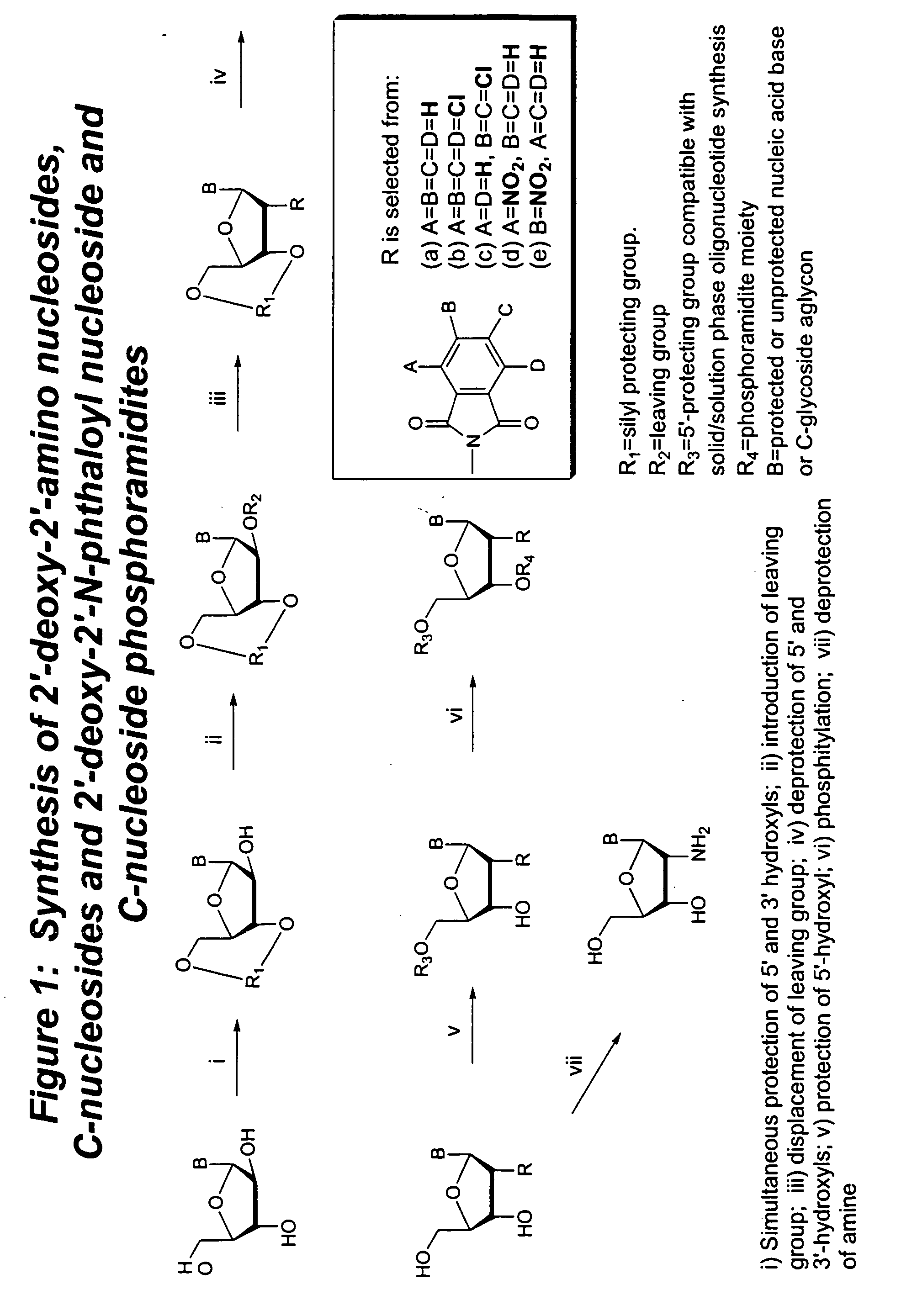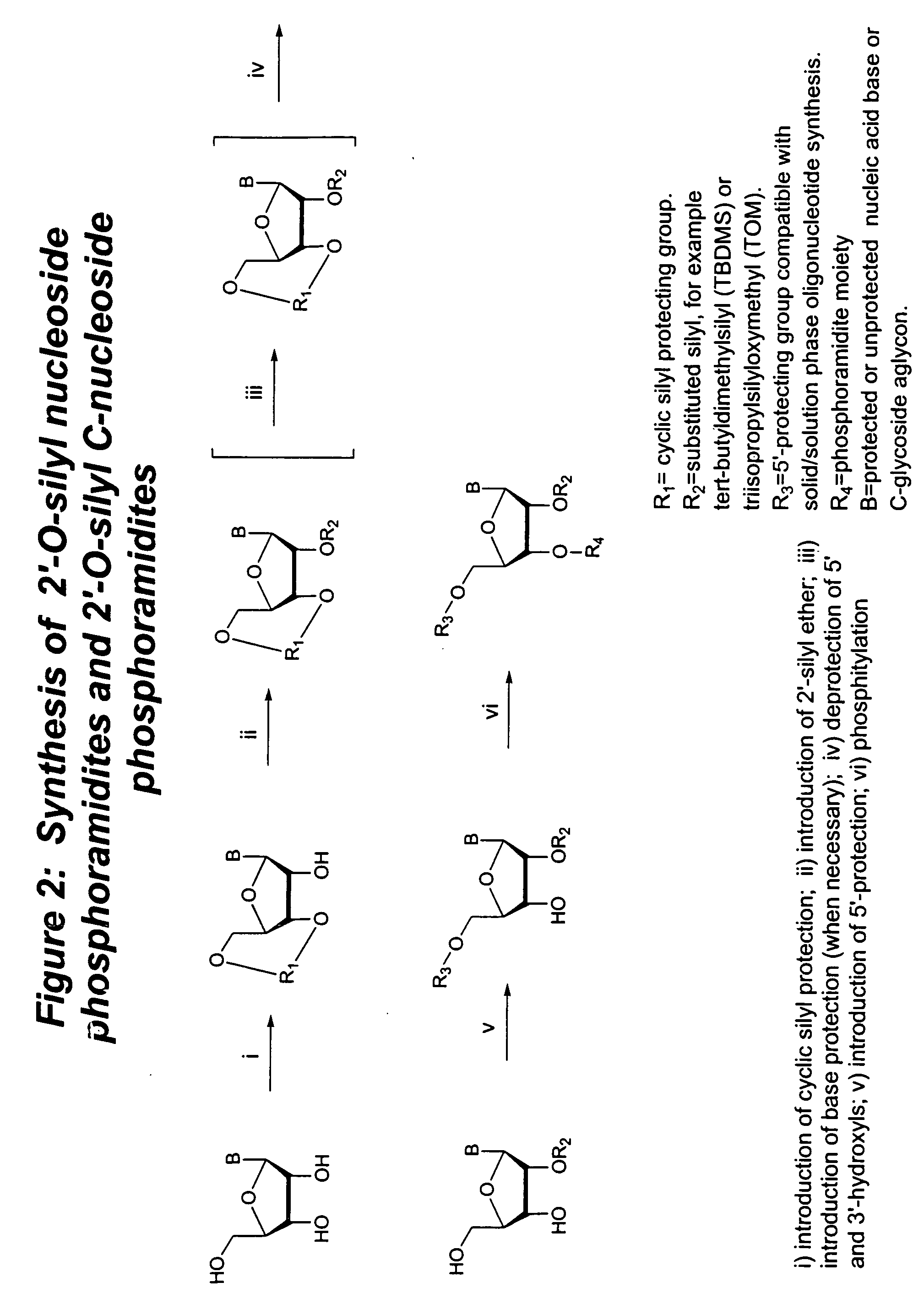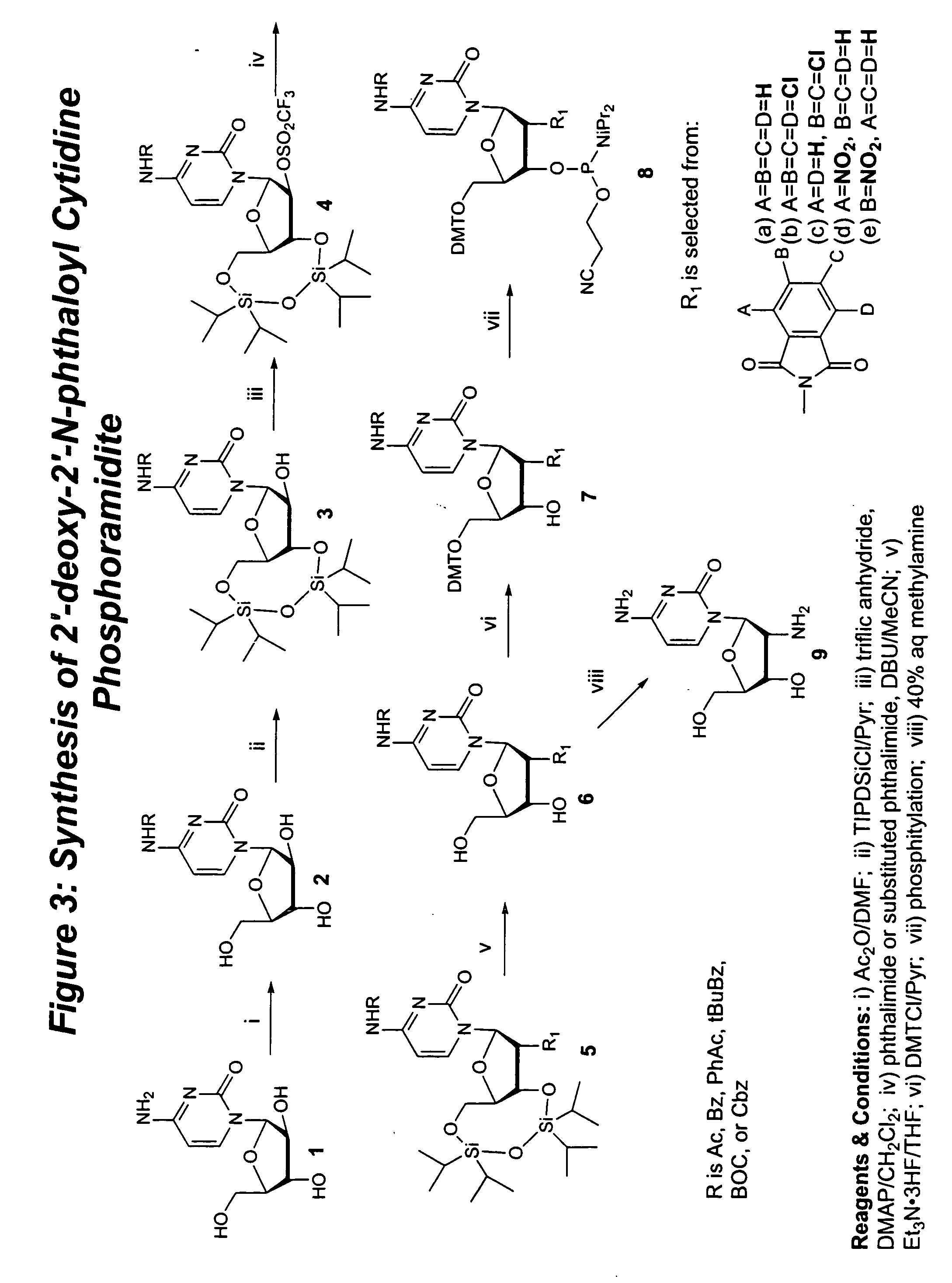Methods for synthesizing nucleosides, nucleoside derivatives and non-nucleoside derivatives
a nucleoside and derivative technology, applied in the field of chemical synthesis of nucleosides, non-nucleoside derivatives, can solve the problems of limited protocols that allowed one to probe structure function relationships, limited research to use natural bases, and the need for efficient synthesis of monomer building blocks, so as to improve the overall synthetic yield
- Summary
- Abstract
- Description
- Claims
- Application Information
AI Technical Summary
Benefits of technology
Problems solved by technology
Method used
Image
Examples
example 1
Synthesis of 5′-O-DMT-2′-deoxy-2′-N-phthaloyl-N4-acetyl cytidine 3′-O-(2-cyanoethyl-N,N-diisopropylphosphoramidite) (8a, R=acetyl). FIG. 3
1-β-D-arabinfuranosyl-N4acetyl cytosine (2, R=acetyl) (modified from Bhat, V; et al., 1989,Nucleosides&Nucleotides, 8(2), 179-83)
1-β-D-arabinofuranosyl-cytosine (Cytarabine) (1), (25 g, 102.75 mmol, Pfanstiehl Laboratories, Cat. No. C-123, Lot #2417 B) was co-evaporated with three portions of DMF (120-ml) and then dissolved in anhydrous DMF (250 ml). Acetic anhydride (11.62 ml, 123.30 mmol) was added dropwise with stirring. After stirring for 24 hours at room temperature, TLC (20% MeOH / CH2Cl2) indicated a complete reaction. The reaction was quenched with anhydrous MeOH (25 ml) and DMF was removed by rotary evaporation and co-evaporation three times with toluene. The crude yellow foam was crystallized from a mixture of diethyl ether / methanol (10:1.) The crystallized product was filtered, washed with diethyl ether and dried to give 27.5 g (94%) o...
example 2
Synthesis of 5′-O-Dimethoxytrityl-2′-Deoxy-2′-N-phthaloyl-uridine 3′-(2-cyanoethyl-N,N-diisopropyl phosphoramidite) (16a), FIG. 4
Synthesis of 5′,3′-O-(tetraisopropyldisiloxane-1,3-di-yl)-1-β-D-arabinofuranosyl-uracil (11)
1-β-D-arabinofuranosyl-uracil (10) (2.44 g, 10 mmol) was dried by two co-evaporations with anhydrous pyridine and then re-dissolved in anhydrous pyridine. The above solution was cooled (0° C.) and a solution of 1,3-dichloro-1,1,3,3-tetraisopropylsiloxane (3.52 mL, 11.0 mmol) in 10 mL of anhydrous dichloromethane was added dropwise with stirring. After the addition was complete, the reaction mixture was allowed to warm to room temperature and was stirred for an additional two hours. The reaction was then quenched with MeOH (10 mL) and evaporated to dryness. The residue was dissolved in dichloromethane and washed with saturated NaHCO3 and brine,dried over Na2SO4, and filtered. The organic layer was evaporated to dryness and then co-evaporated with toluene to remove...
example 3
Synthesis of 5′-O-Dimethoxytrityl-2′-deoxy-2′-N-phthaloyl-N6-tertButylbenzoyl adenosine-3′-(2-cyanoethyl-N,N-diisopropyl phosphoramidite) (25a, R=t-BuBz), FIG. 5
5′,3′-O-tetraisopropyldisiloxy-1-β-D-arabinofuranosyl-adenine (19)
1-β-D-arabinofuranosyl-adenine HCl (18) (5 g, 16.46 mmol, Pfanstiehl Laboratories) was co-evaporated twice from anhydrous pyridine, suspended in anhydrous pyridine (50 ml) and cooled to 0° C. in ice water. 1,3-dichloro-1,1,3,3-tetraisopropyldisiloxane (6.6 ml, 20.23 mmol) was added dropwise to the cold stirred nucleoside solution. After the addition was complete, the reaction mixture was allowed to warm to room temperature and stirred for an additional two hours. The reaction was then quenched with 1 ml of ethanol. Solvents were removed by in vacuo and the residue was dissolved in dichloromethane, washed with saturated sodium bicarbonate solution, dried over sodium sulfate, filtered and evaporated to dryness to give 8.5 g of (19) as a white foam (8.5 g). Pr...
PUM
 Login to View More
Login to View More Abstract
Description
Claims
Application Information
 Login to View More
Login to View More - R&D
- Intellectual Property
- Life Sciences
- Materials
- Tech Scout
- Unparalleled Data Quality
- Higher Quality Content
- 60% Fewer Hallucinations
Browse by: Latest US Patents, China's latest patents, Technical Efficacy Thesaurus, Application Domain, Technology Topic, Popular Technical Reports.
© 2025 PatSnap. All rights reserved.Legal|Privacy policy|Modern Slavery Act Transparency Statement|Sitemap|About US| Contact US: help@patsnap.com



